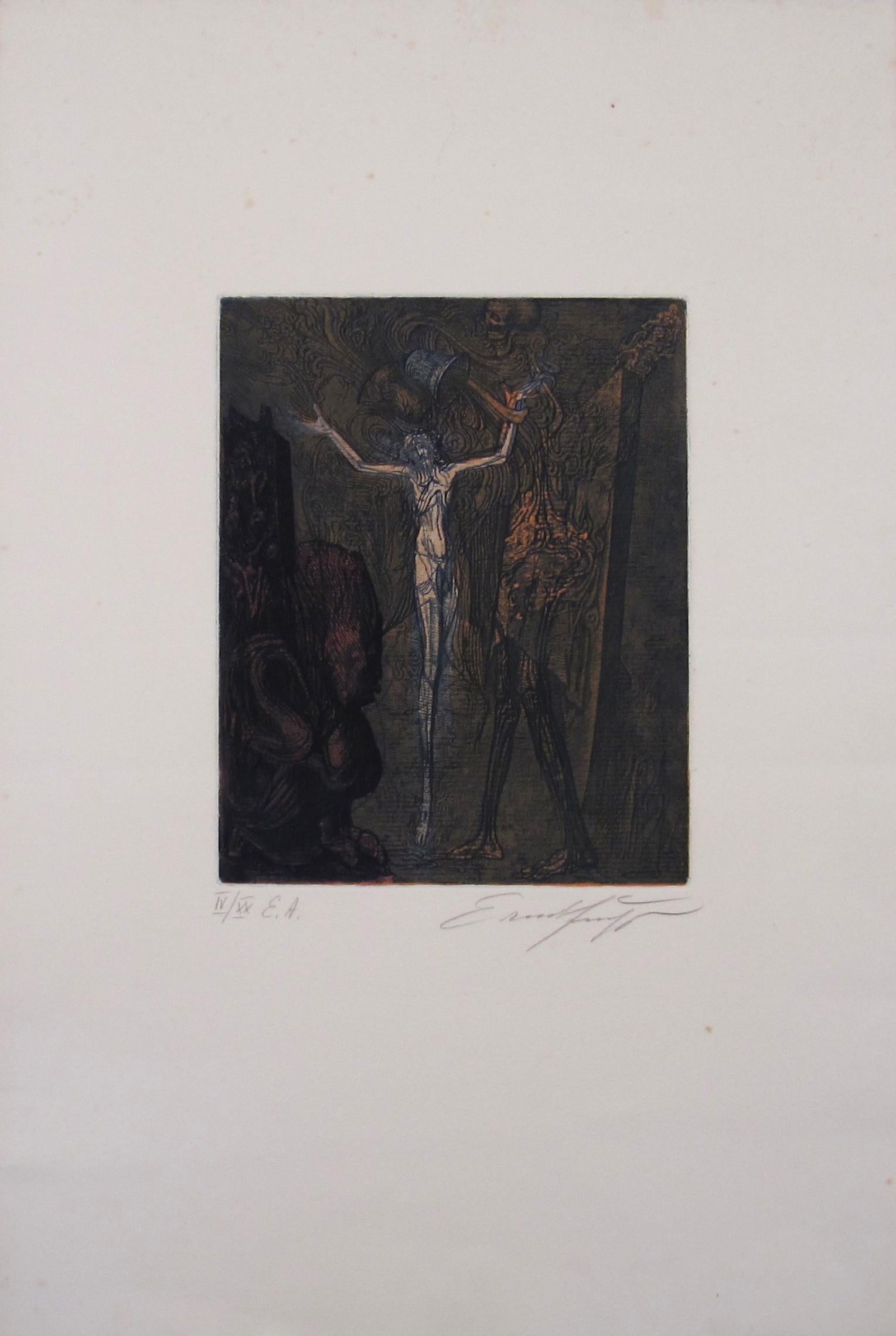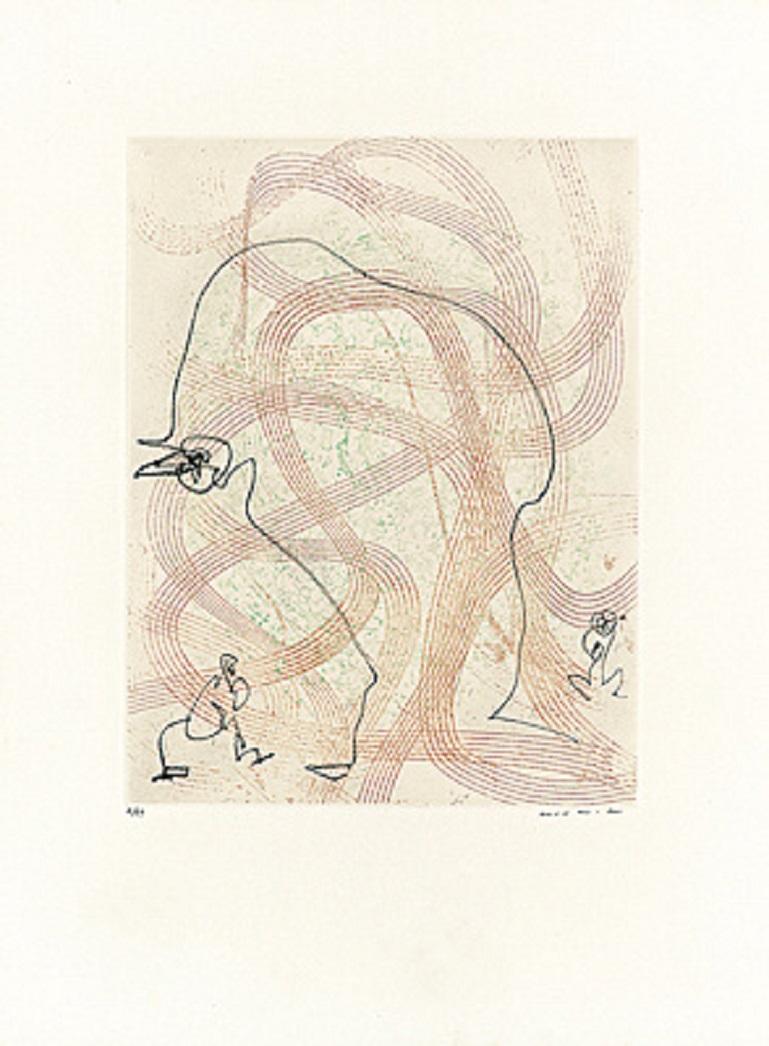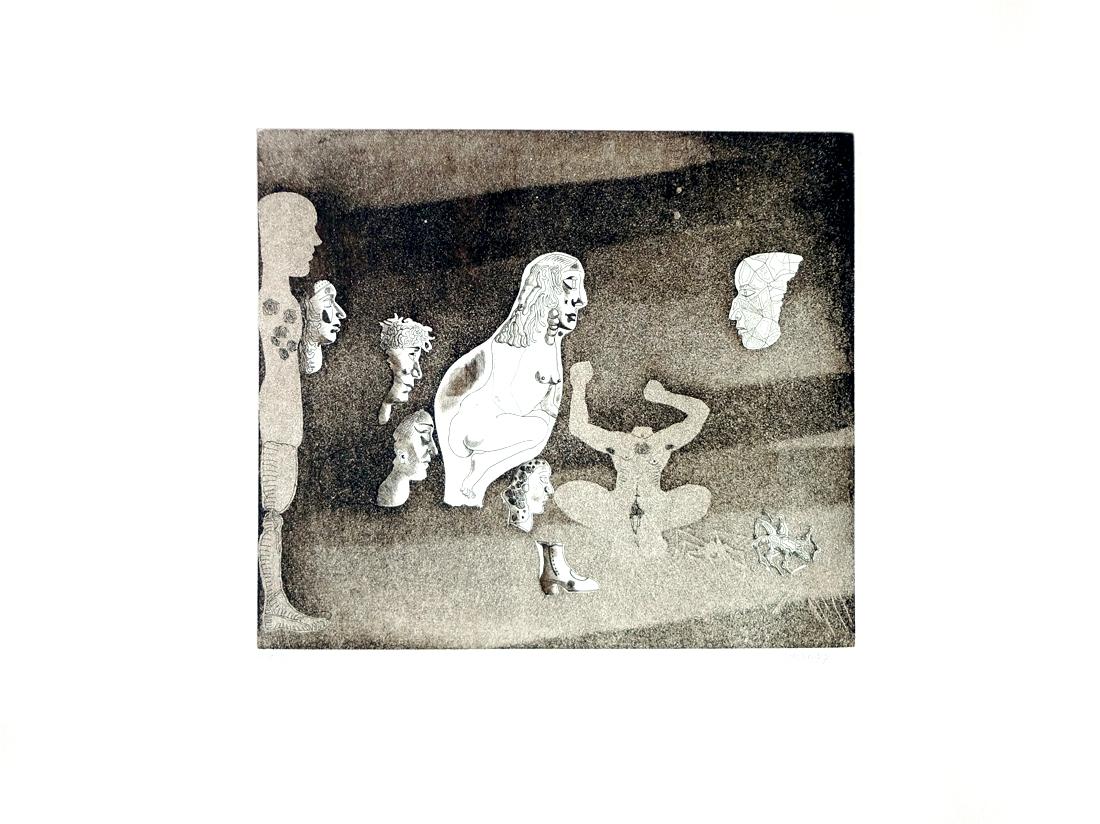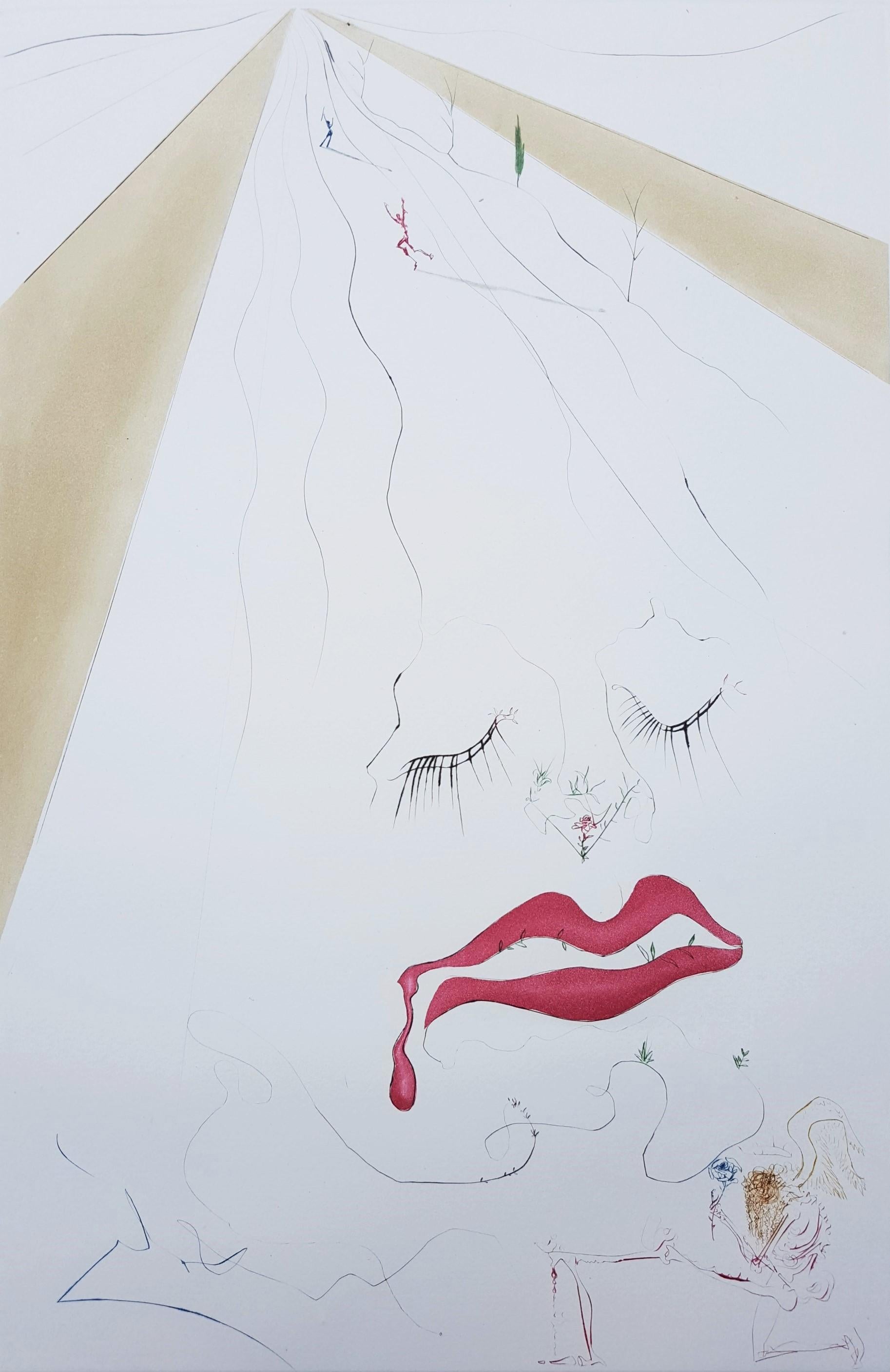Items Similar to "Solidarity, " Etching of an Surrealist Landscape signed by Yves Tanguy
Want more images or videos?
Request additional images or videos from the seller
1 of 7
Yves Tanguy"Solidarity, " Etching of an Surrealist Landscape signed by Yves Tanguy1947
1947
About the Item
"Solidarity" is an original etching by surrealist artist Yves Tanguy. The artist signed the piece in pencil in the lower right and wrote the edition number, 109/150, in the lower left. This piece depicts a variety of surreal figures and forms created with simple contour lines.
3 7/8" x 3 1/8" art
10 1/8" x 9 1/2" frame
Yves Tanguy (1900-1955) was in many respects the quintessential Surrealist. A sociable eccentric who ate spiders as a party trick, and a close friend of Andre Breton, Tanguy was best-known for his misshapen rocks and molten surfaces that lent definition to the Surrealist aesthetic. Self-taught but enormously skilled, Tanguy painted a hyper-real world with exacting precision. His landscapes, a high-octane blend of fact and fiction, captured the attention of important artists and thinkers from Salvador Dalí to Mark Rothko who admitted their debt to the older artist. And even Carl Gustave Jung used a canvas by Tanguy to illustrate his theory of the collective unconscious.
- Creator:Yves Tanguy (1900-1955, American)
- Creation Year:1947
- Dimensions:Height: 10.125 in (25.72 cm)Width: 9.5 in (24.13 cm)
- Medium:
- Movement & Style:
- Period:
- Condition:
- Gallery Location:Milwaukee, WI
- Reference Number:
About the Seller
4.9
Platinum Seller
These expertly vetted sellers are 1stDibs' most experienced sellers and are rated highest by our customers.
Established in 1966
1stDibs seller since 2017
389 sales on 1stDibs
Typical response time: 1 hour
- ShippingRetrieving quote...Ships From: Milwaukee, WI
- Return PolicyA return for this item may be initiated within 14 days of delivery.
More From This SellerView All
- "Hunting, " Original Etching and Aquatint signed by Molly McKeeBy Molly McKeeLocated in Milwaukee, WI"Hunting" is an original etching and aquatint by Molly McKee. The artist signed the piece in the lower right, titled it lower center, and wrote the edition number (2/10) in the lower left. It depicts a few abstracted human figures in McKee's surreal and horror-inspired style. 11 3/4" x 9" art 24 7/8" x 17 1/2" frame This surreal etching...Category
1990s Surrealist Figurative Prints
MaterialsEtching, Aquatint
- "Hinting (With Chine Colle), " Etching & Aquatint signed by Molly McKeeBy Molly McKeeLocated in Milwaukee, WI"Hinting" is an original etching and aquatint made with Chine Colle by Molly McKee. The artist signed the piece in the lower right, titled it lower center, and wrote the edition numb...Category
1990s Surrealist Figurative Prints
MaterialsEtching, Aquatint
- "Demi-God of Discontent, " Original Etching and Aquatint signed by Molly McKeeBy Molly McKeeLocated in Milwaukee, WI"Demi-God of Discontent" is an original etching and aquatint made with Chine Colle by Molly McKee. The artist signed the piece in the lower right, titled it lower center, and wrote the edition number (2/10) in the lower left. It depicts a few abstracted human figures in McKee's surreal and horror-inspired style. 11 3/4" x 9" art 24 7/8" x 17 1/2" frame This surreal etching...Category
1990s Surrealist Figurative Prints
MaterialsEtching, Aquatint
- "Le Bouquet tout fait (The Ready-made Bouquet), " Lithograph after Rene MagritteBy René MagritteLocated in Milwaukee, WI"Le Bouquet tout fait (The Ready-made Bouquet)" is a color lithograph after a 1954 original painting by Rene Magritte. A bourgeois "little man" faces away from the viewer looking towards a fall forest. Flora, the goddess of flowers and season of spring, from Sandro Botticelli's "Primavera" is painted on the back of the man. This juxtaposes fall and spring. Art: 12 x 9.75 in Frame: 22.38 x 20.38 in René-François-Ghislain Magritte was born November 21, 1898, in Lessines, Belgium and died on August 15, 1967 in Brussels. He is one of the most important surrealist artists. Through his art, Magritte creates humor and mystery with juxtapositions and shocking irregularities. Some of his hallmark motifs include the bourgeois “little man,” bowler hats, apples, hidden faces, and contradictory texts. René Magritte’s father was a tailor and his mother was a miller. Tragedy struck Magritte’s life when his mother committed suicide when he was only fourteen. Magritte and his two brothers were thereafter raised by their grandmother. Magritte studied at the Brussels Academy of Fine Arts from 1916 to 1918. After graduating he worked as a wallpaper designer and in advertisement. It was during this period that he married Georgette Berger, whom he had known since they were teenagers. In 1926, René Magritte signed a contract with the Brussels Art Gallery, which allowed him to quit his other jobs and focus completely on creating art. A year later he had his first solo show at the Galerie la Centaurie in Brussels. At this show Magritte exhibited what is today thought of as his first surrealist piece, The Lost Jockey, painted in 1926. In this work a jockey and his steed run across a theater stage, curtains parted on either side. Throughout the scene, there are trees with trunks shaped somewhat like chess pawns with musical scores running vertically up their sides and branches sticking out from all angles. Critics did not enjoy this style of art; it was new, different, and took critical thought to understand, but The Lost Jockey was only the first of many surrealist artworks Magritte would paint. Because of the bad press in Brussels, René and Georgette moved to Paris in 1927, with the hope that this center of avant-garde art would bring him success and recognition. In Paris, he was able to become friends with many other surrealists, including André Breton and Paul Éluard. They were able to learn from and inspire one another, pushing the Surrealist movement further forward. It was also in Paris that Magritte decided to add text to some of his pieces, which was one of the elements that made his artwork stand out. In 1929, he painted one of his most famous oil works: The Treachery of Images. This is the eye-catching piece centered on a pipe. Below the pipe is written “Ceci n’est pas un pipe,” which translates to “This is not a pipe.” This simple sentence upset many critics of the time, for of course it was a pipe. Magritte replied that it was not a pipe, but a representation of a pipe. One could not use this oil on canvas as a pipe, to fill it with tobacco and smoke it. Thus, it was not a pipe. In 1930, Magritte and Georgette moved back to Brussels. Though they would travel to his exhibitions elsewhere, their home going forward would always be in Brussels. Magritte had his first American exhibition at the Julien Levy Gallery in New York City in 1936 and his first show in England two years later in 1938 at The London...Category
2010s Surrealist Figurative Prints
MaterialsLithograph
- "La Reconnaissance Infinie (The Infinite Recognition)" Litho after Rene MagritteBy René MagritteLocated in Milwaukee, WI"La Reconnaissance Infinie (The Infinite Recognition)" is a color lithograph after the 1963 painting by Rene Magritte. Two of Magritte's bourgeois "little men" stand in the sky. Both look away from the viewer talking to each other in the typical outfit of Magritte's men, black trench coats and bowler hats. Art: 15 x 18.25 in Frame: 26.25 x 29.88 in René-François-Ghislain Magritte was born November 21, 1898, in Lessines, Belgium and died on August 15, 1967 in Brussels. He is one of the most important surrealist artists. Through his art, Magritte creates humor and mystery with juxtapositions and shocking irregularities. Some of his hallmark motifs include the bourgeois “little man,” bowler hats, apples, hidden faces, and contradictory texts. René Magritte’s father was a tailor and his mother was a miller. Tragedy struck Magritte’s life when his mother committed suicide when he was only fourteen. Magritte and his two brothers were thereafter raised by their grandmother. Magritte studied at the Brussels Academy of Fine Arts from 1916 to 1918. After graduating he worked as a wallpaper designer and in advertisement. It was during this period that he married Georgette Berger, whom he had known since they were teenagers. In 1926, René Magritte signed a contract with the Brussels Art Gallery, which allowed him to quit his other jobs and focus completely on creating art. A year later he had his first solo show at the Galerie la Centaurie in Brussels. At this show Magritte exhibited what is today thought of as his first surrealist piece, The Lost Jockey, painted in 1926. In this work a jockey and his steed run across a theater stage, curtains parted on either side. Throughout the scene, there are trees with trunks shaped somewhat like chess pawns with musical scores running vertically up their sides and branches sticking out from all angles. Critics did not enjoy this style of art; it was new, different, and took critical thought to understand, but The Lost Jockey was only the first of many surrealist artworks Magritte would paint. Because of the bad press in Brussels, René and Georgette moved to Paris in 1927, with the hope that this center of avant-garde art would bring him success and recognition. In Paris, he was able to become friends with many other surrealists, including André Breton and Paul Éluard. They were able to learn from and inspire one another, pushing the Surrealist movement further forward. It was also in Paris that Magritte decided to add text to some of his pieces, which was one of the elements that made his artwork stand out. In 1929, he painted one of his most famous oil works: The Treachery of Images. This is the eye-catching piece centered on a pipe. Below the pipe is written “Ceci n’est pas un pipe,” which translates to “This is not a pipe.” This simple sentence upset many critics of the time, for of course it was a pipe. Magritte replied that it was not a pipe, but a representation of a pipe. One could not use this oil on canvas as a pipe, to fill it with tobacco and smoke it. Thus, it was not a pipe. In 1930, Magritte and Georgette moved back to Brussels. Though they would travel to his exhibitions elsewhere, their home going forward would always be in Brussels. Magritte had his first American exhibition at the Julien Levy Gallery in New York City in 1936 and his first show in England two years later in 1938 at The London Gallery...Category
2010s Surrealist Figurative Prints
MaterialsLithograph
- "La Grande Guerre (The Great War), " Color Lithograph after Rene MagritteBy René MagritteLocated in Milwaukee, WI"La Grande Guerre (The Great War)" is a color lithograph after the 1964 painting by Rene Magritte. A Victorian lady stands in white facing the viewer. A bouq...Category
2010s Surrealist Figurative Prints
MaterialsLithograph
You May Also Like
- Ernst Fuchs Jesus Crucifixion Aquatint Vienna Fantastic Realism Austria 1972By Ernst FuchsLocated in Meinisberg, CHErnst Fuchs (Austrian, 1930 - 2015) Jesus speaking from the cross A rare Artist proof sheet from the Folio “Jean Paul. Die Rede des toten Christus vom Weltgebaude herab, dass kein Gott sei”, published in 1972 by Propyläen, Berlin, Germany. • Aquatint etching on French Arches paper (watermarked) • Sheet ca. 57 x 38 cm • Plate, ca. 24.7 x 19.7 cm • Signed bottom right • Inscribed in pencil bottom left: IV/XX E. A. (Print No. 4 out a run of twenty, Épreuve d'artiste (Artist’s proof) Worldwide shipping is complimentary - There are no additional charges for handling & delivery. Ernst Fuchs was an Austrian painter...Category
1970s Surrealist Abstract Prints
MaterialsInk, Archival Paper, Aquatint
- "Bonjour" by Max Ernst, Good Day, Surrealism, Light Colors, FigurativeBy Max ErnstLocated in Köln, DEEtching in colours by Max Ernst. "Bonjour", 1966 66,5 x 50,1 cm Copy 7/99 Edition of 111 copies (approx.)Category
1960s Surrealist Figurative Prints
MaterialsEtching, Aquatint
- "Terre des nébuleuses" by Max Ernst, Blue, Fog, SurrealismBy Max ErnstLocated in Köln, DEEtching and aquatint in colours (colour variation) by Max Ernst. "Terre des nébuleuses", 1965 38 x 27,5 cm Copy essai 1/1Category
1960s Surrealist Figurative Prints
MaterialsEtching, Aquatint
- Jorge Castillo - EROTIC COMPOSITION Etching on paper Spanish SurrealismBy Jorge CastilloLocated in Madrid, MadridJorge Castillo - COMPOSICIÓN ERÓTICA (Erotic Composition) Date of creation: 1977 Medium: Etching on paper Edition: 75 + 20 E.A. Size: 50 x 65,5 cm Condition: In perfect conditions an...Category
1970s Surrealist Figurative Prints
MaterialsEngraving, Etching
- Jorge Castillo - MARIENZA EN DOMINGO Etching Spanish Surrealism FeminineBy Jorge CastilloLocated in Madrid, MadridJorge Castillo - MARIENZA EN DOMINGO Date of creation: 1972 Medium: Etching on paper Edition: 150 + H.C. Size: 56 x 70 cm Condition: In perfect conditions and never framed Observatio...Category
1970s Surrealist Figurative Prints
MaterialsPaper, Engraving, Etching
- Transfiguration /// Surrealism Salvador Dali Landscape Etching Face Lips SurrealBy Salvador DalíLocated in Saint Augustine, FLArtist: Salvador Dali (Spanish, 1904-1989) Title: "Transfiguration" *Signed by Dali in pencil lower right Year: 1973 Medium: Original Etching on Auvergne paper Limited edition: 90/10...Category
1970s Surrealist Figurative Prints
MaterialsIntaglio, Etching
Recently Viewed
View AllMore Ways To Browse
Signed Etching By Dali Original
Lentes Vintage
Lent Vintage
Surreal Etching
Salvador Dali Self
Salvador Dali Etching Framed
Aesthetic Vintage Party
Tanguy Yves
Andre Carl
Dali 9
Carl Jung
Dali 1947
Salvador Dali 1947 Dali Original
Yves Tanguy Etching
Original Fashion Poster
Community Plate
Edo Woodblock
Russian Man Portrait





